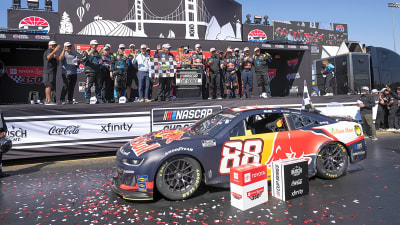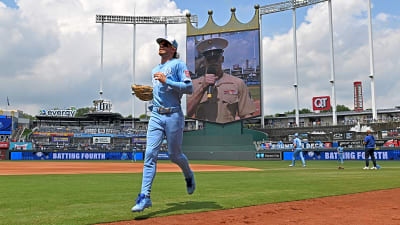Former NBA star Larry Johnson recently revisited one of the most memorable ad campaigns in basketball history during an appearance on the 'All The Smoke' podcast. Johnson, known just as much for his “Grandmama” commercials as for his bruising low-post play, revealed that the beloved ads nearly never happened. All because of an aborted plan with two other Basketball legends.
Johnson, the No. 1 overall pick in the 1991 NBA Draft out of UNLV, said Converse’s original idea was to have him share the screen with Larry Bird and Magic Johnson. At the time, both Bird and Magic were also Converse athletes, and the shoe company saw the chance for a clever passing-of-the-torch moment.
“They said, ‘They’re in marketing, they’re going to put you in a commercial,’” Johnson said on the podcast. “They said, ‘The first commercial is, we’re going to put you in a gurney, cover you up so nobody can see you. Magic Johnson and Larry Bird are the doctors. They’re going, ‘Scalpel, this and that,’ then they say, ‘The perfect basketball player — we gotta name him.’ Larry says, ‘His name’s gotta be Larry,’ and Magic says, ‘No, Johnson.’ Then they say, ‘Larry. Johnson.’ And I rise up and the commercial goes off.”
The concept was a clever play on Johnson’s name, bridging the first names and last names of two Hall of Famers. But the commercial was scrapped before cameras ever rolled.
“When I got to the set, they didn’t tell me nothing,” Johnson said. “I walked into my trailer and saw two or three dresses and wigs. They said, ‘One of them didn’t want to do the commercial. So here’s the new idea.’”
The new idea turned Johnson into “Grandmama,” a gold-toothed, flower-dress-wearing, slam-dunking grandmother. It was risky, absurd and wildly effective.
Converse’s new vice president of marketing at the time, Joanna Jacobson, knew the brand needed a fresh image to keep up with Nike and Reebok. With Pete Favat and Rich Herstek from the Houston Effler agency leading the pitch, they sold Johnson on the outlandish character with one last-ditch plea.
Before the 6-foot-6, 250-pound forward ever put on a dress, Favat flew to Dallas and nervously showed Johnson the storyboard: a prim, churchgoing woman inspired in part by a photo of Ella Fitzgerald in a fancy hat and cat-eye glasses.
“I was ready for him to punch me,” Favat later joked. But Johnson, who was days away from being drafted by the Charlotte Hornets, surprised everyone by agreeing on the spot. “I’m in. Let’s do this,” he said.
For Converse, the gamble worked. Johnson’s Grandmama spots were an instant hit, giving the brand a pop-culture foothold in the Michael Jordan era. Johnson’s star power and the absurdity of the commercials made them unforgettable, running for five years through the early 1990s.
One spot even landed during the 1994 Super Bowl. To convince Converse to pay $1 million for the 30-second slot, a major investment for the struggling brand, which was producer Harry McCoy, literally presented a bullet on a red velvet pillow to Jacobson, asking her to “bite the bullet.”
The Grandmama campaign paid off in more ways than one. Johnson, who won Rookie of the Year in 1992 and became a two-time NBA All-Star, fully embraced the alter ego. The ads captured the humor and charm that balanced his bruising style of play. Fans everywhere wore Grandmama masks to Hornets games, and Johnson even brought the character to TV, guest starring as Grandmama on an episode of Family Matters with Steve Urkel.
Not everything was as smooth as the commercials made it seem. Converse’s shoes lagged behind in technology, and some of the Aero-Glide sneakers Johnson wore for the campaign were notorious for poor quality. To keep up with Nike’s Air and Reebok’s Pump, Converse introduced React Juice, which was a gel that leaked and forced recalls. Despite the quality concerns, Converse did see a spike in sales.
For the first time since the Converse Weapon (worn by both Larry Bird and Magic Johnson), Converse had something that moved numbers. It would be short lived though. By the early 2000s, the brand declared bankruptcy before being bought by Nike in 2003.
Still, the Grandmama spots live on as some of the most iconic athlete endorsements ever. Johnson’s willingness to laugh at himself made him stand out in an era when many stars were far more guarded.
“Larry was totally secure in his masculinity and was a genuinely playful personality,” said the late Rick Bonnell, longtime Hornets beat writer for The Charlotte Observer. “It wouldn’t have worked with a lot of other stars.”
Ironically, Johnson himself once admitted he actually preferred the original Magic and Bird concept and it never aired. “That was what sold me on Converse,” he told Larry Brown Sports in 2011.
In the end, Johnson’s risk paid off in pop-culture gold. Grandmama’s legacy remains bigger than any shoe sales figure or missing championship ring. In a sneaker landscape that invites retroes, now that Nike owns Converse, could create a great opportunity to revitalize the signature line.
Nike would need to make improvements to the original design in the guts of the shoe due to its reputation for poor quality. It’s too late for the ad campaign, but not too late to capitalize on the short lived but noteworthy popularity from 30 years ago. For a generation of NBA fans, Larry Johnson will always be remembered as the high-flying Grandmama who could whoop you in her Sunday best.
More must-reads:
- Mavericks center Dereck Lively II reportedly undergoes foot surgery
- Former two-time All-Star seeking NBA comeback
- The 'Most points in a game by NBA team in 2024-25' quiz
Breaking News
Trending News
Customize Your Newsletter
 +
+
Get the latest news and rumors, customized to your favorite sports and teams. Emailed daily. Always free!








